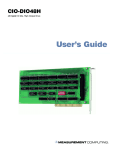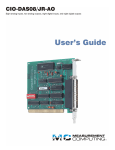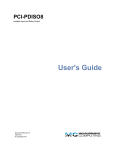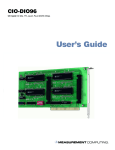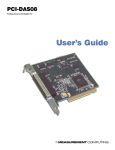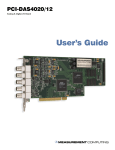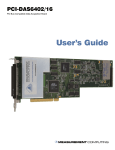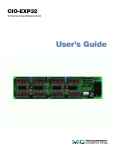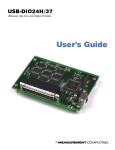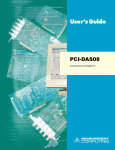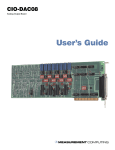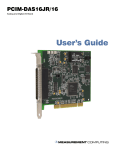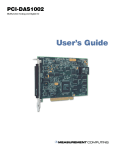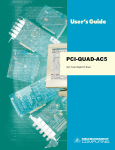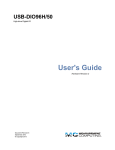Download CIO-DAS08 User's Guide - from Measurement Computing
Transcript
CIO-DAS08 Multifunction Analog and Digital I/O board User's Guide Document Revision 9, January, 2007 © Copyright 2007, Measurement Computing Corporation Your new Measurement Computing product comes with a fantastic extra — Management committed to your satisfaction! Refer to www.mccdaq.com/execteam.html for the names, titles, and contact information of each key executive at Measurement Computing. Thank you for choosing a Measurement Computing product—and congratulations! You own the finest, and you can now enjoy the protection of the most comprehensive warranties and unmatched phone tech support. It’s the embodiment of our mission: To provide PC-based data acquisition hardware and software that will save time and save money. Simple installations minimize the time between setting up your system and actually making measurements. We offer quick and simple access to outstanding live FREE technical support to help integrate MCC products into a DAQ system. Lifetime warranty: Every hardware product manufactured by Measurement Computing Corporation is warranted against defects in materials or workmanship for the life of the product. Products found defective are repaired or replaced promptly. Lifetime Harsh Environment Warranty®: We will replace any product manufactured by Measurement Computing Corporation that is damaged (even due to misuse) for only 50% of the current list price. I/O boards face some tough operating conditions, some more severe than the boards are designed to withstand. When a board becomes damaged, just return the unit with an order for its replacement at only 50% of the current list price. We don’t need to profit from your misfortune. By the way, we honor this warranty for any manufacturer’s board that we have a replacement for. 30 Day Money Back Guarantee: You may return any Measurement Computing Corporation product within 30 days of purchase for a full refund of the price paid for the product being returned. If you are not satisfied, or chose the wrong product by mistake, you do not have to keep it. Please call for an RMA number first. No credits or returns accepted without a copy of the original invoice. Some software products are subject to a repackaging fee. These warranties are in lieu of all other warranties, expressed or implied, including any implied warranty of merchantability or fitness for a particular application. The remedies provided herein are the buyer’s sole and exclusive remedies. Neither Measurement Computing Corporation, nor its employees shall be liable for any direct or indirect, special, incidental or consequential damage arising from the use of its products, even if Measurement Computing Corporation has been notified in advance of the possibility of such damages. HM CIO-DAS08.doc 3 Trademark and Copyright Information TracerDAQ, Universal Library, Harsh Environment Warranty, Measurement Computing Corporation, and the Measurement Computing logo are either trademarks or registered trademarks of Measurement Computing Corporation. Windows, Microsoft, and Visual Studio are either trademarks or registered trademarks of Microsoft Corporation LabVIEW is a trademark of National Instruments. CompactFlash is a registered trademark of SanDisk Corporation. XBee and XBee-PRO are trademarks of MaxStream, Inc. All other trademarks are the property of their respective owners. Information furnished by Measurement Computing Corporation is believed to be accurate and reliable. However, no responsibility is assumed by Measurement Computing Corporation neither for its use; nor for any infringements of patents or other rights of third parties, which may result from its use. No license is granted by implication or otherwise under any patent or copyrights of Measurement Computing Corporation. All rights reserved. No part of this publication may be reproduced, stored in a retrieval system, or transmitted, in any form by any means, electronic, mechanical, by photocopying, recording, or otherwise without the prior written permission of Measurement Computing Corporation. Notice Measurement Computing Corporation does not authorize any Measurement Computing Corporation product for use in life support systems and/or devices without prior written consent from Measurement Computing Corporation. Life support devices/systems are devices or systems which, a) are intended for surgical implantation into the body, or b) support or sustain life and whose failure to perform can be reasonably expected to result in injury. Measurement Computing Corporation products are not designed with the components required, and are not subject to the testing required to ensure a level of reliability suitable for the treatment and diagnosis of people. 4 Table of Contents Preface About this User’s Guide .......................................................................................................................6 What you will learn from this user’s guide.........................................................................................................6 Conventions in this user’s guide.........................................................................................................................6 Where to find more information .........................................................................................................................6 Chapter 1 Introducing the CIO-DAS08..................................................................................................................7 Overview: CIO-DAS08 features.........................................................................................................................7 Software features ................................................................................................................................................7 Chapter 2 Installing the CIO-DAS08......................................................................................................................8 What comes with your CIO-DAS08 shipment?..................................................................................................8 Hardware .......................................................................................................................................................................... 8 Optional components ........................................................................................................................................................ 8 Additional documentation................................................................................................................................................. 8 Configuring the CIO-DAS08..............................................................................................................................9 Base address.....................................................................................................................................................................10 Interrupt level...................................................................................................................................................................11 Clock source ....................................................................................................................................................................11 Analog input range...........................................................................................................................................................12 Installing the CIO-DAS08 ................................................................................................................................12 Connecting the board for I/O operations ..........................................................................................................13 Connectors, cables – I/O connectors ................................................................................................................................13 Cabling.............................................................................................................................................................................14 Field wiring, signal termination, and conditioning ..........................................................................................................15 Chapter 3 Programming and Developing Applications ....................................................................................16 Programming languages ...................................................................................................................................16 Packaged applications programs.......................................................................................................................16 Register-level programming .............................................................................................................................16 Chapter 4 Specifications......................................................................................................................................17 Analog input .....................................................................................................................................................17 Digital Input / Output .......................................................................................................................................17 Counters............................................................................................................................................................18 Power consumption ..........................................................................................................................................18 Environmental ..................................................................................................................................................18 Main connectors and pin out.............................................................................................................................19 Analog connector J1 pin out ............................................................................................................................................19 Digital connector J2 pin out .............................................................................................................................................19 5 Preface About this User’s Guide What you will learn from this user’s guide This user’s guide explains how to install, configure, and use the CIO-DAS08 so that you get the most out of its analog input and digital I/O features. This user’s guide also refers you to related documents available on our web site, and to technical support resources. Conventions in this user’s guide For more information on … Text presented in a box signifies additional information and helpful hints related to the subject matter you are reading. Caution! Shaded caution statements present information to help you avoid injuring yourself and others, damaging your hardware, or losing your data. <#:#> Angle brackets that enclose numbers separated by a colon signify a range of numbers, such as those assigned to registers, bit settings, etc. bold text Bold text is used for the names of objects on the screen, such as buttons, text boxes, and check boxes. For example: 1. Insert the disk or CD and click the OK button. italic text Italic text is used for the names of manuals and help topic titles, and to emphasize a word or phrase. For example: The InstaCal installation procedure is explained in the Quick Start Guide. Never touch the exposed pins or circuit connections on the board. Where to find more information The following electronic documents provide helpful information relevant to the operation of the CIO-DAS08. MCC's Specifications: CIO-DAS08 (the PDF version of the Specifications chapter in this guide) is available on our web site at www.mccdaq.com/pdfs/CIO-DAS08.pdf. MCC's Quick Start Guide is available on our web site at www.mccdaq.com/PDFmanuals/DAQ-Software-Quick-Start.pdf. MCC's Guide to Signal Connections is available on our web site at www.mccdaq.com/signals/signals.pdf. MCC's Universal Library User's Guide is available on our web site at www.mccdaq.com/PDFmanuals/sm-ul-user-guide.pdf. MCC's Universal Library Function Reference is available on our web site at www.mccdaq.com/PDFmanuals/sm-ul-functions.pdf. MCC's Universal Library for LabVIEW™ User’s Guide is available on our web site at www.mccdaq.com/PDFmanuals/SM-UL-LabVIEW.pdf. CIO-DAS08 User's Guide (this document) is also available on our web site at www.mccdaq.com/PDFmanuals/CIO-DAS08.pdf. 6 Chapter 1 Introducing the CIO-DAS08 Overview: CIO-DAS08 features The CIO-DAS08 is a multifunction analog and digital I/O board supported under popular Microsoft® Windows® operating systems. The CIO-DAS08 provides eight single-ended channels of 12-bit analog input, three 16-bit down counter channels, three digital input, four digital output, and 24 digital I/O lines. The analog input range and polarity are selectable with an on-board switch. Bipolar input ranges are ±10 V and ±5 V. The Unipolar input range is 0 to +10 V. You select the base address with onboard dip switches. The interrupt level and pacer source are jumperselectable. You can set the pacer source to use the internal PC clock or an external clock. The CIO-DAS08 has a 37-pin analog connector and an onboard 37-pin digital connector. Four digital output bits and three digital input bits are provided on the board's main connector. A 37-pin connector mounted on the board provides 24 digital I/O bits based on the 82C55 specification. The 24 bits are configured as two eight-bit ports and two four-bit ports. Each of these ports may be individually programmed as input or output. Software features For information on the features of InstaCal and the other software included with your CIO-DAS08, refer to the Quick Start Guide that shipped with your device. The Quick Start Guide is also available in PDF at www.mccdaq.com/PDFmanuals/DAQ-Software-Quick-Start.pdf. Check www.mccdaq.com/download.htm for the latest software version. 7 Chapter 2 Installing the CIO-DAS08 What comes with your CIO-DAS08 shipment? The following items are shipped with the CIO-DAS08. Hardware CIO-DAS08 Optional components You can also order the following MCC products to use with your CIO-DAS08. Cables C37FF-x BP-37 Signal termination and conditioning accessories MCC provides signal conditioning and termination products for use with the CIO-DAS08. Refer to Field wiring, signal termination, and conditioning on page 15 for a complete list of compatible accessory products. Additional documentation In addition to this hardware user's guide, you should also receive the Quick Start Guide (available in PDF at www.mccdaq.com/PDFmanuals/DAQ-Software-Quick-Start.pdf). This booklet supplies a brief description of the software you received with your CIO-DAS08 and information regarding installation of that software. Please read this booklet completely before installing any software or hardware. 8 CIO-DAS08 User's Guide Installing the CIO-DAS08 Configuring the CIO-DAS08 The CIO-DAS08 has two sets of switches and two jumpers that should be set before installing the board in the PC. Mounted on the board is a bank of DIP switches for setting the base address, a jumper for setting the interrupt level and a jumper for setting the pacer source to either the internal PC Clock source or an external clock. A bank of four switches on the connector bracket is used for setting the analog input range. The InstaCal calibration and test program included with the CIO-DAS08 will show you how to configure the board. Run InstaCal before you open your computer and install the board. The location of each switch and jumper on the CIO-DAS08 is shown in Figure 1. Analog Input Range switches Clock Source jumper Digital connector J2 Analog connector J1 Base Address Interrupt Level switches jumper Figure 1. Switch and jumper locations The CIO-DAS08 is shipped with the factory-default settings listed in the table below. Factory-configured default settings Switch/jumper Description Default setting Base address DIP switches Interrupt level jumper Clock source jumper Sets the base address Sets the interrupt level Sets the pacer source as the internal PC clock or an external clock Sets the analog input range and gain 300h (768 decimal) "X" position (no interrupt level set) "24/NC" position (external source) Analog input range and gain ±5V Review the following information to change the default configuration of a jumper or switch. 9 CIO-DAS08 User's Guide Installing the CIO-DAS08 Base address Before you install the CIO-DAS08 in your computer, set the base address by using the dip switches labeled ADDRESS located on the board. The easiest way to set the base address switch is to let InstaCal show you the correct settings. However, if are already familiar with setting ISA base addresses, you may use the base address switch description below to guide your base address selection. Unless there is already another board in your system using address 300 hex (768 decimal), leave the switches as they are set at the factory. The example shown in Figure 2 shows the settings for the factory-default base address of 300 hex. 9 8 7 6 5 4 3 ADDRESS SW A9 A8 A7 A6 A5 A4 A3 HEX 200 100 80 40 20 10 08 Figure 2. Base address switches (300h shown) In the default configuration shown in Figure 2, addresses 9 and 8 are DOWN, and all others are UP. Address 9 = 200 hex (512 decimal) and address 8 = 100 hex (256 decimal); when added together they equal 300 hex (768 decimal). A complete address is constructed by calculating the hexadecimal number which corresponds to all the address bits the CIO-DAS08 can respond to. The range of base addresses is 000h to 3F0h. Certain address are used by the PC, others are free and may be used by the CIO-DAS08 and other expansion boards. Refer to the following table. Disregard the numbers printed on the switch When setting the base address, refer to the numbers printed in white on the printed circuit board. PC I/O Addresses Hex Range Function Hex Range Function 000-00F 020-021 040-043 060-063 060-064 070-071 080-08F 0A0-0A1 0A0-0AF 0C0-0DF 0F0-0FF 1F0-1FF 200-20F 210-21F 238-23B 23C-23F 270-27F 2B0-2BF 8237 DMA #1 8259 PIC #1 8253 TIMER 8255 PPI (XT) 8742 CONTROLLER (AT) CMOS RAM & NMI MASK (AT) DMA PAGE REGISTERS 8259 PIC #2 (AT) NMI MASK (XT) 8237 #2 (AT) 80287 NUMERIC CO-P (AT) HARD DISK (AT) GAME CONTROL EXPANSION UNIT (XT) BUS MOUSE ALT BUS MOUSE PARALLEL PRINTER EGA 2C0-2CF 2D0-2DF 2E0-2E7 2E8-2EF 2F8-2FF 300-30F 310-31F 320-32F 378-37F 380-38F 3B0-3BB 3BC-3BF 3C0-3CF 3C0-3CF 3D0-3DF 3E8-3EF 3F0-3F7 3F8-3FF EGA EGA GPIB (AT) SERIAL PORT SERIAL PORT PROTOTYPE CARD PROTOTYPE CARD HARD DISK (XT) PARALLEL PRINTER SDLC SDLC MDA PARALLEL PRINTER EGA CGA SERIAL PORT FLOPPY DISK SERIAL PORT The CIO-DAS08 base switch can be set for an address in the span of 000-3F0h, so it should not be hard to find a free address area. If you are not using IBM prototyping cards, or some other board which occupies these addresses, then 300-31F HEX are free to use. Addresses not specifically listed — such as 390-39Fh — are free. 10 CIO-DAS08 User's Guide Installing the CIO-DAS08 Interrupt level Set the interrupt jumper only if your software requires it. If you do set the interrupt jumper, check your PC's current configuration for interrupt conflicts. Do not use IR2 in PC/AT class machines (or higher). Use the jumper block labeled INT above the PC bus interface (gold pins) to set the interrupt. The board is shipped with the jumper in the "X" position, which means that no interrupt level is set (Figure 3). 2 3 4 5 6 7 X INT Figure 3. Interrupt level select jumper (no interrupt level set) To pace conversions through hardware (either the on-board pacer or an external clock), move this jumper to another position. The CIO-DAS08 can use interrupt levels 2 through 7. Refer to the following table for some typical interrupt assignments on a computer. The levels most often available are 5 and 7. Hardware interrupt assignments Name Description Name Description NMI IRQ0 (AT) IRQ1 IRQ2 Parity Timer IRQ8 IRQ9 Real Time Clock (AT) RE-directed to IRQ2 Keyboard Reserved (XT) INT 8-15 (AT) COM OR SDLC COM OR SDLC Hard Disk (XT) LPT (AT) Floppy Disk LPT IRQ10 IRQ11 Unassigned Unassigned IRQ12 IRQ13 IRQ14 Unassigned 80287 MUNERIC CO-P Hard Disk IRQ3 IRQ4 IRQ5 IRQ6 IRQ7 IRQ15 Unassigned Note: IRQ8-15 are AT only Clock source NC 24 6 With revision 4 and higher hardware, you can use the on-board pacer clock to trigger A/D conversions by setting the clock source jumper (labeled J on the board) to the 6/24 position. This setting routes the pacer output (pin 6) to the interrupt input (pin 24). By default, this jumper is configured as not connected (NC). Refer to Figure 4. Figure 4. Clock source jumper (default setting) Note: to pace conversions with the on-board pacer, you must also select a hardware interrupt by configuring the interrupt level select jumper (discussed above). 11 CIO-DAS08 User's Guide Installing the CIO-DAS08 Analog input range Configure the signal polarity and the analog input range setting using the four dip switches accessible through the CIO-DAS08 connector bracket (Figure 5). These switches set the input range for the analog inputs. Available bipolar input ranges are ±10 V and ±5 V. The Unipolar input range is 0 to +10 V. RANGE SELECT SWITCHES S4 S3 S2 S1 +/- 5 Volt Range Shown Figure 5. Range select switches The CIO-DAS08 is shipped with the analog input range configured for ±5 volts. To change the range, refer to Figure 5 and the table below to determine the correct positions of switches S1 through S4 for the range and gain you want to set. You do not have to turn off the PC power or disconnect signals to change these switch settings. Range Switch Settings Range S1 S2 S3 S4 Gain Resolution ±5 V ±10 V 0-10 V Left Right Left Right Left Right Left Left Right Right Right Left 1 0.5 1 2.44 mV / bit 4.88 mV / bit 2.44 mV / bit Positions other than those shown in the table are not valid. Installing the CIO-DAS08 After configuring the board, install the CIO-DAS08 into your computer. Follow the steps below. Install the MCC DAQ software before you install your board The driver needed to run your board is installed with the MCC DAQ software. Therefore, you need to install the MCC DAQ software before you install your board. Refer to the Quick Start Guide for instructions on installing the software. 1. Turn your computer off, open it up, and insert your board into an available ISA slot. 2. Close your computer and turn it on. 3. To test your installation and configure your board, run the InstaCal utility you installed in the previous section. Refer to the Quick Start Guide that came with your board www.mccdaq.com/PDFmanuals/DAQSoftware-Quick-Start.pdf for information on how to initially set up and load InstaCal. 12 CIO-DAS08 User's Guide Installing the CIO-DAS08 Connecting the board for I/O operations Connectors, cables – I/O connectors The table below lists the board connector, applicable cables, and compatible accessory products. Board connector, cables, and accessory equipment Connector type Compatible cables with analog connector J1 Compatible cables with digital connector J2 Compatible accessory products with the C37FF-x cable, C37FFS-x cable, and the BP-37 cable Analog connector (J1): 37-pin male "D" connector Digital connector (J2): 37-pin male "D" connector C37FF-x C37-FFS-x BP-37 CIO-MINI37 CIO-TERMINAL CIO-SPADE50 CIO-EXP16 CIO-EXP32 Pin out – Analog connector (J1) The analog connector (J1) is a 37-pin, type D connector that is accessible from the rear of the PC through the expansion backplate (see Figure 6). Range S4 S3 S2 S1 +10V Ref LLGND LLGND LLGND LLGND LLGND LLGND LLGND Dig Common Digital Out 4 Digital Out 3 Digital Out 2 Digital Out 1 Counter 2 Out Counter 1 Out Counter 1 In Counter 0 Out Counter 0 In +12V PC Bus 19 18 17 16 15 14 13 12 11 10 9 8 7 6 5 4 3 2 1 37 36 35 34 33 32 31 30 29 28 27 26 25 24 23 22 21 20 CH0 High CH1 High CH2 High CH3 High CH4 High CH5 High CH6 High CH7 High +5V Dig. GND Digital In 3 Digital In 2 Digital In 1 Interrupt Input Gate 2 Gate 1 Gate 0 -12V PC bus Figure 6. 37-pin analog connector 13 CIO-DAS08 User's Guide Installing the CIO-DAS08 Pin out – Digital connector (J2) The digital connector (J2) is a 37-pin, type D connector that is mounted on the CIO-DAS08 board (see Figure 7). This connector is identical to the CIO-DIO24 connector, except that the Interrupt Input and Interrupt Enable pins are not provided. These are no-connect pins (NC) on the CIO-DAS08. The CIO-DAS08 has an interrupt input pin at pin 24 on the analog connector J1. GND +5V GND +12V GND -12V GND -5V GND FIRSTPORTB Bit 0 FIRSTPORTB Bit 1 FIRSTPORTB Bit 2 FIRSTPORTB Bit 3 FIRSTPORTB Bit 4 FIRSTPORTB Bit 5 FIRSTPORTB Bit 6 FIRSTPORTB Bit 7 NC NC 19 18 17 16 15 14 13 12 11 10 9 8 7 6 5 4 3 2 1 37 36 35 34 33 32 31 30 29 28 27 26 25 24 23 22 21 20 FIRSTPORTA Bit 0 FIRSTPORTA Bit 1 FIRSTPORTA Bit 2 FIRSTPORTA Bit 3 FIRSTPORTA Bit 4 FIRSTPORTA Bit 5 FIRSTPORTA Bit 6 FIRSTPORTA Bit 7 FIRSTPORTC Bit 0 FIRSTPORTC Bit 1 FIRSTPORTC Bit 2 FIRSTPORTC Bit 3 FIRSTPORTC Bit 4 FIRSTPORTC Bit 5 FIRSTPORTC Bit 6 FIRSTPORTC Bit 7 GND +5V Figure 7. 37-pin digital connector Use a BP-37 backplate and cable assembly to bring signals from the digital connector to the backplate. BP-37 terminates with a 37-pin male backplate connector. You can run a standard C37FF-2 cable alongside the analog connector (J1) through the gap in the expansion slot backplate. Cabling The red stripe identifies pin # 1 20 19 37 19 37 20 1 1 Figure 8. C37FF-x cable 37 20 19 37 20 1 Figure 9. C37FFS-x cable 14 19 1 CIO-DAS08 User's Guide 37 20 Installing the CIO-DAS08 19 19 The red stripe identifies pin # 1 1 37 20 1 Figure 10. BP-37 cable Field wiring, signal termination, and conditioning You can use the following screw termination and signal conditioning products with the C37FF-x or C37FFS cable. CIO-MINI37 – 37-pin screw terminal board. Details on this product are available on our web site at CIO-TERMINAL – 37-pin screw terminal board with on-board prototyping area. Details on this product are CIO-SPADE50 — 16" x 4" termination panel which mates with both 37-pin and 50-pin connectors. Details BP-37 – Backplate with 37-pin male connector/cable. Details on this product are available on our web site www.mccdaq.com/cbicatalog/cbiproduct.asp?dept_id=102&pf_id=255. available on our web site at www.mccdaq.com/cbicatalog/cbiproduct.asp?dept_id=102&pf_id=282. on this product are available on our web site at www.mccdaq.com/pdfs/screw.pdf at www.mccdaq.com/cbicatalog/cbiproduct.asp?dept_id=103&pf_id=1. CIO-EXP16 – 16-channel analog multiplexer board with on-board CJC sensor. Details on this product are available on our web site at www.mccdaq.com/cbicatalog/cbiproduct.asp?dept_id=126&pf_id=249. CIO-EXP32 – 32-channel analog multiplexer board with an on-board CJC sensor and 2 gain amps. Details are available on our web site at www.mccdaq.com/cbicatalog/cbiproduct.asp?dept_id=126&pf_id=250. Information on signal connections General information regarding signal connection and configuration is available in the Guide to Signal Connections (available at www.mccdaq.com/signals/signals.pdf). 15 Chapter 3 Programming and Developing Applications After following the installation instructions in Chapter 2, your board should now be installed and ready for use. In general there may be no correspondence among registers for different boards. Software written at the register level for other models will not function correctly with your board. Programming languages Measurement Computing’s Universal Library provides access to board functions from a variety of Windows programming languages. If you are planning to write programs, or would like to run the example programs for Visual Basic or any other language, please refer to the Universal Library User's Guide (available on our web site at www.mccdaq.com/PDFmanuals/sm-ul-user-guide.pdf). Packaged applications programs Many packaged application programs now have drivers for your board. If the package you own does not have drivers for your board, please fax or e-mail the package name and the revision number from the install disks. We will research the package for you and advise how to obtain drivers. Some application drivers are included with the Universal Library package, but not with the application package. If you have purchased an application package directly from the software vendor, you may need to purchase our Universal Library and drivers. Please contact us by phone, fax or e-mail: Phone: 508-946-5100 and follow the instructions for reaching Tech Support. Fax: 508-946-9500 to the attention of Tech Support Email: [email protected] Register-level programming You should use the Universal Library or one of the packaged application programs mentioned above to control your board. Only experienced programmers should try register-level programming. If you need to program at the register level in your application, refer to the Register Map for the CIO-DAS08. This document is available on our website at www.mccdaq.com/registermaps/RegMapCIO-DAS08.pdf. 16 Chapter 4 Specifications Typical for 25 °C unless otherwise specified. Specifications in italic text are guaranteed by design. Analog input Table 1. Analog input specifications Parameter Specification A/D converter type Resolution Number of channels Input ranges Polarity A/D pacing A/D trigger sources Data transfer DMA A/D conversion time Throughput Accuracy Differential linearity error Integral linearity error No missing codes guaranteed Gain drift (A/D specs) Zero drift (A/D specs) Common Mode Range CMRR Input leakage current (@ 25 °C) Input impedance Absolute maximum input voltage Noise Distribution (Rate = 1 to 20 kHz) AD574 12-bits 8 single-ended ±10 V, ±5 V, 0 to +10 V, switch selectable Unipolar/Bipolar, switch selectable Software polled (typically through ISR paced by on-board counter) External polled digital input trigger (Digital In 1) Software polled (typically through ISR paced by on-board counter) None 25 µs 20 kHz, PC dependent ±0.01% of reading ±1 LSB ±1 LSB ±0.5 LSB 12-bits ±25 ppm/°C ±10 µV/°C ±10 V 72 dB 100 nA 10 Meg Ohms min ±35 V Avg % ± 2 bins Avg % ± 1 bin Avg # bins Bipolar (10 V) 100% 100% 3 bins Bipolar (5 V) 100% 100% 3 bins Unipolar (10 V) 100% 100% 3 bins Digital Input / Output Table 2. Digital input/output specifications (main connector – J1) Digital type (main connector J1) Configuration Number of channels Output high Output low Input high Input low Output power-up / reset state Output: 74LS273 Input: 74LS244 4 fixed output bits, 3 fixed input bits 4 out, 3 in 2.7 volts min @ -0.4 mA 0.4 volts max @ 8 mA 2.0 volts min, 7 volts absolute max 0.8 volts max, -0.5 volts absolute min 17 CIO-DAS08 User's Guide Specifications Table 3. Digital input/output specifications (digital connector – J2) Digital type (digital I/O connector J2) Configuration Number of channels Output high Output low Input high Input low Power-up / reset state 82C55 2 banks of 8, 2 banks of 4, programmable by bank as input or output 24 I/O 3.0 volts min @ -2.5 mA 0.4 volts max @ 2.5 mA 2.0 volts min, 5.5 volts absolute max 0.8 volts max, -0.5 volts absolute min Input mode (high impedance) Table 4. Interrupt specifications Interrupts Interrupt enable Interrupt sources 2 - 7, jumper selectable Programmable External (Interrupt In), rising edge; on-board counter, jumper selectable Counters Table 5. Counter specifications Counter type Configuration Counter 0 — Independent, user configurable Counter 1 — Independent, user configurable Counter 2 — Independent, user configurable Clock input frequency High pulse width (clock input) Low pulse width (clock input) Gate width high Gate width low Input low voltage Input high voltage Output low voltage Output high voltage 82C54 3 down counters, 16-bits each Source: User connector (Counter 0 In) Gate: User connector (Gate 0) Output: User connector (Counter 0 Out) Source: User connector (Counter 1 In) Gate: User connector (Gate 1) Output: User connector (Counter 1 Out) Source: PC SysClk via divide by 2 circuit Gate: User connector (Gate 2) Output: User connector (Counter 2 Out) 10 MHz max 30 ns min 50 ns min 50 ns min 50 ns min 0.8 V max 2.0 V min 0.4 V max 3.0 V min Power consumption Table 6. Power consumption specifications Parameter Specification +5V +12V -12V 250 mA typical, 312 mA max 15 mA typical, 21 mA max 25 mA typical, 35 mA max Environmental Table 7. Environmental specifications Operating temperature range Storage temperature range Humidity 0 to 50 ° C -20 to 70 ° C 0 to 90% non-condensing 18 CIO-DAS08 User's Guide Specifications Main connectors and pin out Table 8. Connector specifications Connector type Compatible cables with analog connector J1 Compatible cables with digital connector J2 Compatible accessory products with the C37FF-x cable, C37FFS-x cable, and the BP-37 cable Analog connector (J1): 37-pin male "D" connector Digital connector (J2): 37-pin male "D" connector C37FF-x C37-FFS-x BP-37 CIO-MINI37 CIO-TERMINAL CIO-SPADE50 CIO-EXP16 CIO-EXP32 Analog connector J1 pin out Table 9. Analog connector J1 pin out Pin 1 2 3 4 5 6 7 8 9 10 11 12 13 14 15 16 17 18 19 Signal Name +12V PC Bus Counter 0 In Counter 0 Out Counter 1 In Counter 1 Out Counter 2 Out Digital Out 1 Digital Out 2 Digital Out 3 Digital Out 4 Dig Common LLGND LLGND LLGND LLGND LLGND LLGND LLGND +10V Ref Pin 20 21 22 23 24 25 26 27 28 29 30 31 32 33 34 35 36 37 Signal Name -12V PC Bus Gate 0 Gate 1 Gate 3 Interrupt Input Digital In 1 Digital In 2 Digital In 3 Dig GND +5V CH7 High CH6 High CH5 High CH4 High CH3 High CH2 High CH1 High CH0 High Digital connector J2 pin out Table 10. Digital connector J2 pin out Pin 1 2 3 4 5 6 7 8 9 10 11 12 13 14 15 16 17 18 19 Signal Name NC NC FIRSPORTB Bit 7 FIRSPORTB Bit 6 FIRSPORTB Bit 5 FIRSPORTB Bit 4 FIRSPORTB Bit 3 FIRSPORTB Bit 2 FIRSPORTB Bit 1 FIRSPORTB Bit 0 GND -5V GND -12V GND +12V GND +5V GND Pin 20 21 22 23 24 25 26 27 28 29 30 31 32 33 34 35 36 37 Signal Name +5V GND FIRSPORTC Bit 7 FIRSPORTC Bit 6 FIRSPORTC Bit 5 FIRSPORTC Bit 4 FIRSPORTC Bit 3 FIRSPORTC Bit 2 FIRSPORTC Bit 1 FIRSPORTC Bit 0 FIRSPORTA Bit 7 FIRSPORTA Bit 6 FIRSPORTA Bit 5 FIRSPORTA Bit 4 FIRSPORTA Bit 3 FIRSPORTA Bit 2 FIRSPORTA Bit 1 FIRSPORTA Bit 0 19 Declaration of Conformity Manufacturer: Address: Category: Measurement Computing Corporation 10 Commerce Way Suite 1008 Norton, MA 02766 USA Electrical equipment for measurement, control and laboratory use. Measurement Computing Corporation declares under sole responsibility that the product CIO-DAS08 to which this declaration relates is in conformity with the relevant provisions of the following standards or other documents: EU EMC Directive 89/336/EEC: Electromagnetic Compatibility, EN55022 (1987), EN50082-1 Emissions: Group 1, Class B EN55022 (1987): Radiated and Conducted emissions. Immunity: EN50082-1 IEC 801-2 (1987): Electrostatic Discharge immunity, Criteria A. IEC 801-3 (1984): Radiated Electromagnetic Field immunity Criteria A. IEC 801-4 (1988): Electric Fast Transient Burst immunity Criteria A. Declaration of Conformity based on tests conducted by Chomerics Test Services, Woburn, MA 01801, USA in November, 1995. Test records are outlined in Chomerics Test Report #EMI0168A.95. We hereby declare that the equipment specified conforms to the above Directives and Standards. Carl Haapaoja, Director of Quality Assurance Measurement Computing Corporation 10 Commerce Way Suite 1008 Norton, Massachusetts 02766 (508) 946-5100 Fax: (508) 946-9500 E-mail: [email protected] www.mccdaq.com





















